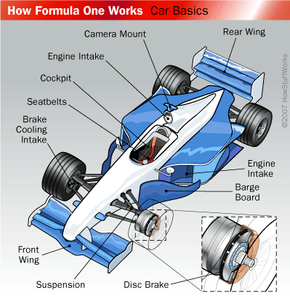Formula One Cars
Fundamentally, Formula One cars are no different than the Chevy parked out in your garage. They use internal combustion engines and have transmissions, suspensions, wheels and brakes. But that's where the similarity ends. Formula One cars aren't designed for casual driving or cruising down the interstate. Everything about them is tweaked and tooled for one thing and one thing only -- speed. Formula One cars can easily attain speeds of 200 mph -- but during a race, the speeds are generally lower. During the 2006 Hungarian Grand Prix, the winner's average speed was 101.769 mph, and in the 2006 Italian Grand Prix, it was 152.749 mph.
Let's take a look at the major systems of a Formula One car.
Advertisement
Chassis
The heart of a Formula One car is the chassis -- the part of the automobile onto which everything is bolted and attached. Like most modern cars and aircraft, Formula One race cars feature monocoque construction. Monocoque is a French word meaning "single shell," which refers to the process of making the entire body out of a single piece of material. Once upon a time, that material was aluminum, but today it's a strong composite, like spun carbon fibers set in resin or carbon fiber layered over aluminum mesh. The result is a lightweight car that can withstand the enormous downward-acting forces that are produced as the vehicle moves through the air.
The monocoque incorporates the cockpit, a strong, padded cell that accommodates a single driver. Unlike the cockpits of road-ready cars, which can show great variance, the cockpits of Formula One cars must adhere to very rigorous technical regulations. They must, for example, meet minimum size requirements and must have a flat floor. The seat, however, is made to fit a driver's precise measurements so his movement is limited as the car moves around the track.
Engine
Before 2006, Formula One cars were powered by massive three-liter, V10 engines. Then the rules changed, specifying the use of 2.4-liter V8 engines. Even though power outputs fell with the rule change, Formula One engines can still produce nearly 900 horsepower. To put that into perspective, consider that a Volkswagen Jetta's 2.5-liter engine produces just 150 horsepower. Of course, the Jetta's engine is probably good for at least 100,000 miles or so. A Formula One engine needs to be rebuilt after about 500 miles. Why? Because generating all of that power requires that the engine run at very high revolution rates -- nearly 19,000 revolutions per minute. Running an engine at such high rpms produces an enormous amount of heat and puts a great deal of stress on the moving parts.
The fuel that powers such an engine is not the typical unleaded gasoline you pump at the neighborhood Exxon, but it's similar. Small quantities of non-hydrocarbon compounds are allowed, but most power-boosting additives have been banned completely. All in all, Formula One teams use about 50 different fuel blends, tuned for different tracks or conditions, in a typical season. Each blend must be submitted to the FIA, the sport's governing body, for approval of its composition and physical properties.
